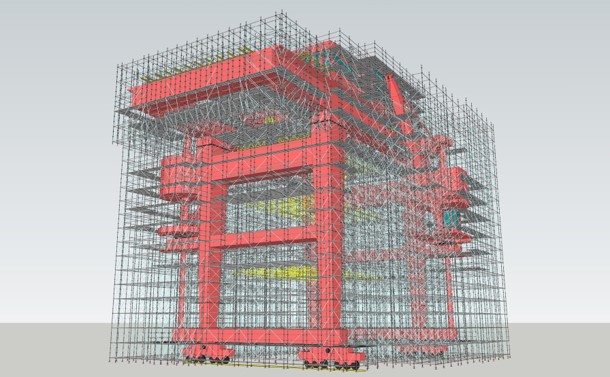What is the Maximum Load for a Scaffold?

Wondering how much weight a scaffold can support? The maximum load capacity depends on the type of scaffold, ranging from light-duty to heavy-duty scaffolds, each designed to handle specific weight limits.
The maximum load for scaffolding varies by type: light-duty scaffolds support up to 120 kg/m², medium-duty scaffolds up to 240 kg/m², and heavy-duty scaffolds can handle up to 450 kg/m². It’s crucial to choose the correct type based on the project’s weight-bearing requirements.
The maximum load a scaffold can support depends on its duty rating and type. Here are the key points about scaffold load capacities:
Scaffold Duty Ratings
Scaffolds are typically classified into three duty ratings:
- Light-duty scaffolding: Can support up to 25 pounds per square foot
- Medium-duty scaffolding: Can support up to 50 pounds per square foot
- Heavy-duty scaffolding: Can support up to 75 pounds per square foot
Factors Affecting Load Capacity
Several factors influence a scaffold’s weight capacity:
- Scaffold type and design
- Materials used (e.g. steel vs wood)
- Construction method
- Condition of components
Safety Factor
Scaffolds must be able to support their own weight plus at least 4 times the maximum intended load. This safety factor is built into the rated load capacities.
Calculating Total Capacity
To determine the total load capacity:
- Multiply the duty rating (25, 50, or 75 lbs/sq ft) by the platform area in square feet
- Factor in the number of workers, tools, equipment, and materials that will be on the scaffold
Checking for Overloading
The deflection method can be used to check if a scaffold is overloaded:
- Platforms should not deflect more than 1/60 of the span when loaded
- For example, a 5 foot (60 inch) span should not deflect more than 1 inch
It’s crucial to never exceed the maximum intended load or rated capacity of a scaffold. Always consult manufacturer guidelines and have qualified personnel determine appropriate load limits for each specific scaffolding setup.
Now that you know the basic weight capacities for different scaffolding types, let’s explore how load capacity is determined, why it matters, and what factors influence the safe usage of scaffolds.
Contents
- What is the Maximum Load for a Scaffold?
- Scaffold Duty Ratings
- Factors Affecting Load Capacity
- Safety Factor
- Calculating Total Capacity
- Checking for Overloading
- How is the Load Capacity of a Scaffold Determined?
- What is the Maximum Load for Light-Duty Scaffolding?
- What is the Maximum Load for Medium-Duty Scaffolding?
- What is the Maximum Load for Heavy-Duty Scaffolding?
- What is the Maximum Load All Scaffolds Must Support?
- What Factors Influence Scaffold Load Capacity?
- Conclusion
How is the Load Capacity of a Scaffold Determined?
Unsure how scaffold load limits are set? Load capacity is determined based on materials used, structural design, and safety standards, ensuring scaffolds can bear worker weight, tools, and materials safely.
The load capacity of a scaffold is determined by the materials, design, and adherence to safety standards like OSHA regulations. These factors ensure that scaffolding can safely support workers, tools, and materials without risk of collapse.
The load capacity of a scaffold is primarily determined by the materials used in its construction, such as steel or aluminum, which affect its overall strength. The design and assembly of the scaffold, including the use of braces, couplers, and support elements, also influence the amount of weight the scaffold can bear. In addition, regulatory bodies like OSHA (Occupational Safety and Health Administration) or local safety authorities provide guidelines to ensure scaffolding meets specific safety standards. These regulations specify the maximum load that each type of scaffold can safely carry, ensuring it supports the weight of workers, tools, and materials during construction. Regular inspections and maintenance also play a role in maintaining the integrity and load-bearing capacity of scaffolding.
What is the Maximum Load for Light-Duty Scaffolding?
Working with light-duty scaffolding? This type is designed for minimal tasks, supporting a maximum load of 120 kg/m², making it ideal for lightweight jobs like painting or cleaning.
Light-duty scaffolding has a maximum load capacity of 120 kg/m², which is sufficient for small-scale jobs like painting, cleaning, or window repairs. It’s not suited for tasks requiring heavy materials or multiple workers due to its limited weight-bearing ability.
Light-duty scaffolding is specifically designed for lightweight tasks where the load-bearing requirements are minimal. It can support a maximum load of 120 kg per square meter, making it suitable for smaller jobs such as painting, cleaning, or window repairs. This type of scaffolding is often used in residential projects or minor maintenance tasks, where the structure only needs to support a worker, a few tools, and light materials. It is important to avoid exceeding this load limit, as overloading light-duty scaffolding can result in structural instability and increase the risk of accidents.
What is the Maximum Load for Medium-Duty Scaffolding?
Using medium-duty scaffolding? It can handle a maximum load of 240 kg/m², making it suitable for tasks like bricklaying, roofing, or plastering where heavier materials are required.
Medium-duty scaffolding can support up to 240 kg/m² and is commonly used for tasks like bricklaying, roofing, and plastering. This increased load capacity allows for heavier materials and multiple workers, providing a stable working platform.
Medium-duty scaffolding has a maximum load capacity of 240 kg per square meter, making it ideal for more demanding tasks that require heavier materials and equipment. It’s commonly used in bricklaying, roofing, plastering, and other medium-scale construction projects where multiple workers may need to use the scaffold at once. This load capacity ensures that the scaffold remains stable while supporting both workers and the weight of materials such as bricks, tiles, or tools. However, exceeding this limit can lead to accidents or structural failure, so it’s important to ensure that the scaffold is not overloaded and that proper safety checks are conducted regularly.
What is the Maximum Load for Heavy-Duty Scaffolding?
Need heavy-duty support? Heavy-duty scaffolding can handle a maximum load of 450 kg/m², making it suitable for tasks involving large equipment, concrete, or steelwork on industrial-scale projects.
Heavy-duty scaffolding supports loads up to 450 kg/m², making it ideal for large construction projects involving concrete work, steel fabrication, or tasks that require heavy equipment. It provides a safe and stable platform for high-risk, high-weight construction activities.
Heavy-duty scaffolding is designed to handle the most demanding construction tasks, with a maximum load capacity of 450 kg per square meter. This makes it suitable for industrial projects that require the use of heavy equipment, concrete work, or steel fabrication. The robust design of heavy-duty scaffolding ensures that it can safely support the weight of multiple workers, large materials, and heavy machinery, making it essential for large-scale projects like high-rise buildings or industrial facilities. It’s critical to adhere to the maximum load capacity to avoid accidents and ensure the safety of everyone on-site.
What is the Maximum Load All Scaffolds Must Support?
Concerned about safety standards? According to OSHA, all scaffolds must support their own weight plus at least four times the intended load, ensuring they can safely handle workers, tools, and materials.
OSHA regulations require that all scaffolds must support at least four times the intended load, including their own weight. This safety standard ensures that scaffolds remain stable during use, protecting workers and equipment from accidents and structural failure.
According to OSHA regulations, all scaffolds must be able to support their own weight plus at least four times the intended load. This standard ensures that scaffolding is strong enough to handle the combined weight of workers, tools, and materials while providing a margin of safety to prevent collapse. For example, if a scaffold is expected to carry a load of 100 kg, it must be built to support at least 400 kg, including its own weight. This safety factor is crucial in preventing accidents and ensuring that scaffolds remain stable under the pressures of daily use. Regular inspections are also required to ensure that scaffolds continue to meet these safety standards throughout the project.
What Factors Influence Scaffold Load Capacity?
Worried about scaffold load limits? Several factors influence scaffold load capacity, including materials, design, bracing, and the number of workers, ensuring the structure can handle specific weight requirements.
Factors influencing scaffold load capacity include the materials used, such as steel or aluminum, the design of the structure, including braces and couplers, and the number of workers and equipment placed on the platform. Adhering to safety guidelines ensures scaffold stability.
Several factors influence the load capacity of scaffolding, ensuring it can support the necessary weight for different projects. The first factor is the material used in the construction of the scaffold, with steel and aluminum being the most common materials for their strength and durability. The design of the scaffold, including the use of braces, ledgers, and transoms, also impacts its ability to bear weight. Additionally, the type of scaffolding—whether light-duty, medium-duty, or heavy-duty—dictates the maximum load it can handle. The number of workers on the scaffold and the weight of the tools or materials they use must also be considered. Overloading the scaffold beyond its intended capacity can compromise its stability and lead to accidents.
Conclusion
In conclusion, the maximum load for scaffolding varies by type: light-duty scaffolds support up to 120 kg/m², medium-duty scaffolds up to 240 kg/m², and heavy-duty scaffolds can handle up to 450 kg/m². Choosing the correct scaffold ensures worker safety and project efficiency.
